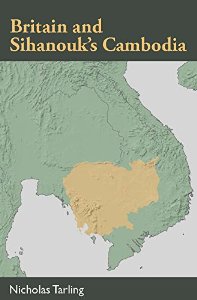From the outset, it’s worth nothing that this isn’t a book for everybody and it probably won’t be flying off the shelves. It’s a nearly 400-page-long, densely annotated analysis of the diplomatic relations between Britain and Cambodia between 1964 and 1970. That may or may not be your thing. If it is, you’re gonna love this book.
The problem, however, is that Britain played a pretty minor role in shaping Cambodia’s history during this period. British influence in the region had faded alarmingly after India’s independence in 1947, and even more so after Burma’s in 1948, so despite the flood of diplomatic cables and papers quoted in the book, its role really didn’t amount to much. In 1967 the British closed its military bases in Malaysia and Singapore, really bringing the curtain down on its strategic role in the region.
Of most interest to the author, Nicholas Tarling, is the gap between Britain’s need to play along with the diplomatic interests of the United States, at the height of the Cold War, and its own rather more neutral King Sihanouk-centric philosophy.
While Sihanouk bravely strove to maintain Cambodia’s neutrality, caught between the superpowers’ travails in Vietnam, both China and the US put him under enormous and unsustainable pressure. Britain also had to try to find a middle ground, recognising as it did the existence of the People’s Republic of China (which the US did not, until 1979) and would have been happy to see a non-aligned Southeast Asia, much as Sihanouk would have done.
King Sihanouk is the most interesting personality in the book (almost all the other characters being minor Foreign Office mandarins of the mid-1960s). While Tarling talks of Sihanouk’s ‘baffling’ and ‘mercurial personality’, his ‘flamboyance’, ‘exaggerated vanity’ and ‘outrageous speeches’, one never really gets a sense of the man; buried beneath the thick layers of academic verbiage, Sihanouk fails to come alive as the spectacular character he clearly was.
While Britain privately admitted that it had had ‘nothing but trouble from the touchy, temperamental and doubtfully sane ruler’, it recognised that continuing diplomatic relations might help prevent Cambodia becoming a satellite of China, and ‘exasperating and unpredictable though the personality of Prince Sihanouk might be, he has so far maintained the peace and unity of Cambodia’. Sadly, this was not to be: Sihanouk was overthrown in March 1970, and Cambodia’s long slide into the hell of civil war and the Khmer Rouge really began.
Far more interesting to the general reader was Britain’s behaviour towards Cambodia after the fall of the Khmer Rouge: between 1985 and 1989, authorised by Prime Minister Margaret Thatcher, Britain’s elite SAS military regiment ran a series of training camps for Khmer Rouge allies in Thailand close to the Cambodian border and created a ‘sabotage battalion’ of 250 experts in explosives and ambushes. That sadly falls outside the scope of this book.
Britain And Sihanouk’s Cambodia, by Nicholas Tarling, is now available from Monument Books for $39.50
